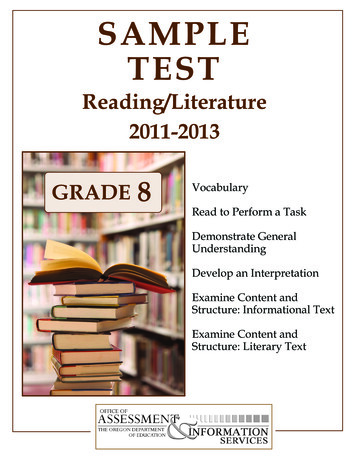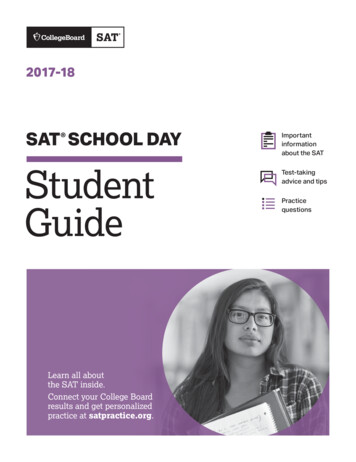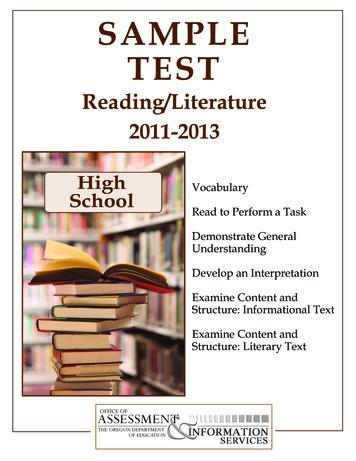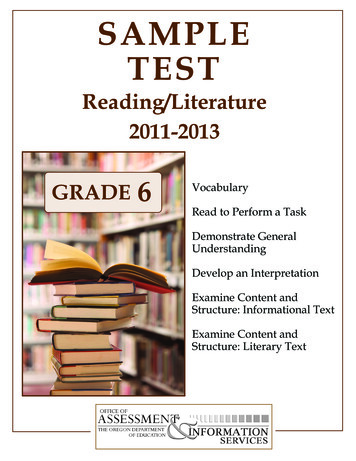
Transcription
aryRead to Perform a TaskDemonstrate GeneralUnderstandingDevelop an InterpretationExamine Content andStructure: Informational TextExamine Content andStructure: Literary Text
It is the policy of the State Board of Education and a priority of the Oregon Department of Educationthat there will be no discrimination or harassment on the grounds of race, color, sex, marital status,religion, national origin, age or handicap in any educational programs, activities, or employment.Persons having questions about equal opportunity and nondiscrimination should contact the StateSuperintendent of Public Instruction at the Oregon Department of Education.Office of Assessment & Information ServicesOregon Department of Education255 Capitol Street NESalem, OR 97310(503) 947-5600Susan CastilloState Superintendent of Public InstructionDoug KostyAssistant SuperintendentKen HermensLanguage Arts Assessment SpecialistJames LeighMathematics Assessment SpecialistSteve SlaterManager, Scoring, Psychometrics and ValidityDianna CarrizalesDirector, Monitoring, Systems, and OutcomesKathleen VanderwallManager, Test Design and AdministrationBradley J. LenhardtMonitoring and Assessment SpecialistHolly CarterAssessment Operations and Policy AnalystSheila SomervilleElectronic Publishing SpecialistMichelle McCoyELPA and Assessment Implementation SpecialistKathy BusbyProject Manager
Reading and Literature DIRECTIONSRead each of the passages. Then read the questions that follow and decide on the BESTanswer. There are a lot of different kinds of questions, so read each question carefullybefore marking an answer on your answer sheet.GRANNY ED’S TEAMRead this excerpt from the story GRANNY ED AND THE LEWISVILLE RAIDERS to find outhow Granny Ed became the coach.IT NEVER OCCURRED TO ME that Granny Ed was differentfrom other grandmothers. Her name was out of the ordinarybut she always said, “If your parents put a handle likeEdwinalou on you, you’d prefer a nickname too.” It madegood sense to me. She had normal grandmother interests likeknitting, baking, and attending my basketball games.Basketball! I eat and sleep the sport, but right then Iwished I’d never heard of it. Our high school team hadbasketball Trouble. I mean Trouble with a capital T.Coach Marshall was a super coach, and we had highhopes of finishing first in the district this year. Whathappened? December second, Coach Marshall had a car accidentover by Murphy Junction. He ended up in the hospital with abroken back and will be in the hospital two months—plus a longconvalescence. To make matters worse, the only other man teacherin our high school is Mr. LaFrance, who doesn’t know whether youbounce, kick, or bury a basketball. That leaves the LewisvilleRaiders coachless.The team had gathered at our house, as usual, due to GrannyEd’s weakness for feeding hungry ballplayers.“Men, we’ve got troubles if the principal can’t come up withsomeone to take Coach Marshall’s place,” Al James said, betweenhuge bites of pizza.Office of Assessment and Information ServicesOregon Department of Education2011-2013 Sample Test, Grade 81August 2011
Reading and Literature “Wish my dad could help out, but he’s working swing shift atthe sawmill,” said Leftie.“If Grandpa Thor were still living, he would take over,” I addedsadly. “He was a great college coach before he died.” The teamnodded in sympathetic agreement and respect.“If we could just get someone to come to the gym and superviseour practices, maybe we could stumble along until a replacementfor Coach Marshall is found,” Al said.“That’s easier said than done. All the teachers are alreadydoubling up on classes” I said, feeling more discouraged everyminute.“Well, gentlemen, if a body is all you need at practice, I cancertainly provide that,” Granny Ed spoke from the doorway.“You’re sure not going to let a little problem like this throw amonkey wrench in the Lewisville Raider team, are you?”There was a long silence. I wanted to sink through the floor.Granny Ed at practice! Oh no! You’ve really done it this time, GrannyEd, I thought.1How was Granny Ed different than other grandmothers?A. She enjoyed her grandson.B. She attended basketball games.C. She enjoyed knitting and baking.D. She coached high school basketball.2The phrase “throw a monkey wrench in it” meansA. a specific tool.B. ruin a good situation.C. a maneuver in basketball.D. put in a new coach.Office of Assessment and Information ServicesOregon Department of Education2011-2013 Sample Test, Grade 82August 2011
Reading and Literature 3Which of the following phrases does the author use to foreshadow later events in thestory?A. “Coach Marshall was a super coach.”B. “Granny Ed was different from other grandmothers.”C. “Wish my dad could help out.”D. “Teachers are already doubling up on classes.”4From which point of view is this story told?A. First personB. Second personC. Third personD. Granny Ed’s5Which statement from the story best supports that Granny Ed intends to coach the team?A. “It never occurred to me that Granny Ed was different.”B. “That leaves the Lewisville Raiders coachless.”C. “If a body is all you need at practice.”D. “I wanted to sink through the floor.”THROUGH A DOG’S EYESAre dogs really colorblind? Read this article from POPULAR SCIENCE magazine to learnhow dogs see things differently than people do.IT’S A MISTAKEN NOTION that dogs see only in black and white. Ifhowever, what you mean by colorblind is that dogs see only aportion of the visible spectrum as compared withwhat humans see, then yes, dogs are colorblind.Dogs have two types of color photoreceptors,or cone cells, on their retinas that recognize shortand medium-to-long wavelengths of light,corresponding to bluish hues (short wavelength)and red-yellow ones (long wavelength). People,on the other hand, have three types of cone cells that enable us tosee the full range of colors that make up the visible spectrum. SinceOffice of Assessment and Information ServicesOregon Department of Education2011-2013 Sample Test, Grade 83August 2011
Reading and Literature dogs have only two types of cone cells, the colors they candistinguish are almost identical to the colors a human would seewho has red-green colorblindness. Of course, colorblind humansstill see many different colors, and scientists think dogs see thisrange of colors as well.How do scientists know? One way is to shine beams of coloredlights into dogs’ eyes and analyze the spectrum, or pattern, of lightthat is reflected back. The results are then compared with thepattern produced when the same lights are shined into humaneyes.Another way to study canine vision is to have the dogs “tell”scientists what they see. In one experiment, dogs are shown a seriesof three lights; in each case, two of the three lights are the samecolor. With a minimal amount of training, the dogs select with theirnoses the colored light that is different from the others. By varyingthe colors of the lights and repeating the process, scientists havedetermined that dogs see the world in black, white, and shades ofgray, with long wavelength (red-yellow) and short wavelength(blue) colors thrown in.6This passage refers to “the visible spectrum.” The visible spectrum is best defined asA. bluish hues of color.B. a broad number of colors.C. photoreceptors.D. medium-to-long wavelengths.7The author includes a question in paragraph 3 of this selection. The author’s purposefor this is toA. let readers know they don’t have to read it all.B. show that the author is unsure of the exact answer.C. repeat facts that the reader really needs to know.D. help draw the reader into the article.Office of Assessment and Information ServicesOregon Department of Education2011-2013 Sample Test, Grade 84August 2011
Reading and Literature 8Based on the evidence in this selection, which statement below is accurate?A. Scientists have an untested theory that dogs are color blind.B. Scientists perform surgery to study dogs’ eyes.C. Scientists have evidence that dogs are colorblind.D. Scientists cannot really tell what dogs can see.9Based on this author’s style of writing, this article was probably written for whichaudience?A. Veterinarians who specialize in eye diseasesB. Everyday pet ownersC. Scientists who design experimentsD. Those interested in different kinds of dogs10What is one way to study how dogs see?A. By analyzing the shape of a dog’s eyeB. By comparing the structure of different dog speciesC. By flashing a series of white lights into a dog’s eyeD. By teaching dogs to select colors of lightPACK IT UPIf you’re ever in the market for a backpack, you might want to consider this usefulconsumer information from CONSUMER REPORTS magazine.MOST KIDS’ BACKPACKS CAN easily hold school necessities. Is onepack better than another or are they pretty much equal behind thebrand name and the price tag?To find out, we bought a half-dozen moderately priced packsplus a messenger bag, all reported to be hot sellers. We then asked18 middle-school boys and girls to check them out. We ran lab testsfor durability, water-resistance, and other practical stuff to generatethe ratings below.The kids didn’t favor one backpack over another. But theyquickly made it clear that they preferred a traditional backpack tothe messenger bag’s single-strap design.Office of Assessment and Information ServicesOregon Department of Education2011-2013 Sample Test, Grade 85August 2011
Reading and Literature What the Tests ShowedAll the backpacks are sturdy enough to withstand daily abuseor a tug-of-war at the bus stop. Water-resistance varies. Most did agood job of withstanding the lab equivalent of a 5-minute shower.Construction details do matter, to parents if not always to kids.A good pack should have the following features; most of the bagswe tested have them:Shoulder straps that are contoured and padded to soften the load.A waist belt to stabilize the pack and transfer weight to the hips.A padded or quilted back or one with mesh fabric to make thebag less sweaty on steamy days.Compression straps on the sides to snug up a partially filledbackpack.Look for multiple pockets: small ones for a calculator or cellphone, a key holder, and a concealed interior pocket for cash.The REI Whitney has a great deal going for it and could even beused for hiking. But at 55, it’s the most expensive backpack in thegroup. The Kelty Gemini is very versatile and only 35. It’s a CRBest Buy. The Timbuk2 El Ocho messenger bag, 65, proved verysturdy and water-resistant but it lacks a backpack’s assortment offeatures, which lowered its score in the Ratings.Office of Assessment and Information ServicesOregon Department of Education2011-2013 Sample Test, Grade 86August 2011
Reading and Literature 11Which features are designed to help make the backpacks more comfortable for thewearer?A. Shoulder straps and compression strapsB. Quilted back and multiple pocketsC. Waist belt and compression strapsD. Quilted back and shoulder straps12Based on the ratings chart, which statement is true?A. Sturdiness was generally the most impressive aspect of the backpacks tested.B. Cost had the most impact on where backpacks ended up in the ratings.C. Only one of the backpacks fell below an overall score of “Good.”D. Only two backpacks received more than one “Excellent” rating.13The least expensive backpack on the list probably falls in the rankings primarily due toA. a fair rating in resisting water.B. a lack of features and sturdiness.C. its nontraditional design.D. a lack of appeal to kids.14The Timbuk 2 has the lowest rating due toA. its cost and its “features” rating.B. low kids appeal and cost.C. lack of waterproofing and low overall rating.D. small size and sturdiness.HOLD YOUR GROUND!TAKE ME OUT TO THE BALLPARK by Josh Leventhal has a great deal of informationabout this all-American sport and its interesting cast of characters. Read this excerpt tolearn more about a side of baseball many fans may not know about.WEATHERMAN AND BOTANIST, chemist and protector, the MajorLeague groundskeeper shoulders responsibilities that reach farbeyond cutting grass. The caretakers of baseball’s cathedrals are in aperpetual dance with Mother Nature, watching the weather, testingOffice of Assessment and Information ServicesOregon Department of Education2011-2013 Sample Test, Grade 87August 2011
Reading and Literature new strains of grass or cutting patterns so the grass wears evenly, andmaintaining the overall health of the field. Infield dirt and outfieldgrass need constant care and attention; it is the charge ofgroundskeepers and their crew to provide a consistent surface.While fans can see a team’s strategy unfold during the course of agame, what they don’t see can sometimes have a major impact on theoutcome. Before the game even begins, groundskeepers can—anddo—alter the field to play to the home team’s strengths andundermine those of the visitors. If the home team is having troublefielding grounders, a groundskeeper might add extra dirt to theinfield to slow the ball down, or perhaps let the grass grow a littlelong along the baselines. The grounds crew for the Detroit Tigers usedto soak the area in front of home plate to help keep Ty Cobb’s bunts infair territory—this came to be known as “Cobb’s Lake.” Somegroundskeepers will modify the pitcher’s mound to create a keyadvantage for the home team, loosening the dirt or packing it down infront of the pitching rubber. Hall of Fame pitcher Catfish Hunter, forexample, preferred a soft mound; opposing groundskeepers wouldpack it down or water it and let the sun harden it before a game. Insome ballparks the mounds in the visiting bullpens are at differentheights from the one on the field, so as to addle the opposition.Another common groundskeeping tactic is watering down thebase paths to slow down visiting base stealers. The San FranciscoGiants employed this maneuver in the early 1960s whenever theDodgers and speedster Maury Wills came to town. They didn’talways get away with it, however; just before the start of the 1962playoff between the Dodgers and Giants, umpire Jocko Conlannoticed that the area around first base wasexcessively wet. He ordered Candlestick Park headgroundskeeper Matty Schwab to repair the area,delaying the start of the game for over an hour. WhatConlan didn’t notice, however, was that Schwab andAlvin Dark (the Giants manager, later dubbed the“Swamp Fox”) had also overwatered the left side ofthe infield to make up for the weak Giants infielders.These efforts were not in vain, as the Giants won theseries, and Schwab was honored for his contributionOffice of Assessment and Information ServicesOregon Department of Education2011-2013 Sample Test, Grade 88August 2011
Reading and Literature to the team’s success.Such tricks, known as “diamond doctoring,” have a long historyin the Major Leagues. On game days, umpires and opposingmanagers must take a close look at the field in search of any unfairinconsistencies in the playing surface. Most of the time, however,groundskeeping is about keeping the infield dirt the way their teamlikes it, and making sure that the grass is even and healthy.Groundskeepers are constantly combating fungi, diseases and insectsthat can kill whole sections of a field overnight. They carefullyanalyze the health of the grass, choose appropriate fertilizers andrehabilitate the field after heavy rains. During the season, it makes fora long day—most groundskeepers work 16 to 18 hours a day.Dragging the infield during the fifth inning has become astandard part of every groundskeeper’s repertoire. The traditionbegan with the Reds in the early 1950s. General Manager Gabe Paulnoticed that the break in the game meant increased concession sales,and the practice gradually became the norm around the League. In1968 the Mets GM Johnny Murphy successfully lobbied for a new rulerequiring that the infield be dragged every five innings, after a badbounce in the 24th inning resulted in a loss to the Astros. In someparks, the extra minute or two it takes to drag the infield is anopportunity for on-field entertainment. The Yankee grounds crew, forexample, does a choreographed routine to the ’70s disco hit “YMCA”that has become as much a part of a trip to Yankee Stadium as theseventh-inning stretch.Although it takes a whole crew to properly care for a ball field, afew individuals stand out for their groundskeeping prowess. GeorgeToma, longtime groundskeeper for the Kansas City Royals, iscurrently the most revered. Beyond his baseball responsibilities, Tomaruns the crew for the football Chiefs and has prepared the field formore than 30 Super Bowls. Fenway’s diamond doctor, Joe Mooney, isknown for his strict rules; many an unsuspecting reporter or curioustourist has set foot on Fenway’s famous green, only to be barked at bythe protective Mooney. In 1999 Heather Nabozny made history as thefirst female head groundskeeper in Major League baseball, when shewas hired to replace 35-year veteran Frank Feneck at Tigers Stadium.Office of Assessment and Information ServicesOregon Department of Education2011-2013 Sample Test, Grade 89August 2011
Reading and Literature 15The author states that some groundskeepers “stand out for their groundskeepingprowess.” As used here, prowess meansA. trickery.B. honesty.C. skill.D. dedication.16What was Cobb’s Lake?A. A famous ballparkB. A muddy areaC. A pitcher’s moundD. A skillful bunt17Why would mounds of different heights addle or confuse visiting pitchers?A. The shorter mounds would make it difficult to throw strikes.B. There was a greater chance of being struck by a ball hit by an opposing player.C. The pitchers would be distracted by playing conditions they were not used to.D. The umpire would call strikes and balls based on the home team’s preference.18The author probably wrote the first paragraph because it introduces theA. conflict to be developed later.B. range of the groundskeepers’ work.C. unethical practices occurring in major league baseball.D. colorful characters who play the game.19The effect the author is trying to create by the phrase “baseball’s cathedrals” in thesecond sentence is toA. suggest a sense of awe and respect for ballparks.B. associate the tall buildings with the adventure of being in Europe.C. imply that many people spend Sunday afternoons at a ballpark.D. appeal to readers who would rather worship outdoors.Office of Assessment and Information ServicesOregon Department of Education2011-2013 Sample Test, Grade 810August 2011
Reading and Literature THE HARVESTThe following story is part of a longer work entitled THINGS FALL APART by ChinuaAchebe. In this scene, the main character of Okonkwo has gone to Nwakibie, an olderfarmer in his Nigerian village, to make a request.“I HAVE COME TO YOU FOR HELP,” he said. “Perhaps you canalready guess what it is. I have cleared a farm but have no yams tosow. I know what it is to ask a man to trust another with his yams,especially these days when young men are afraid of hard work. Iam not afraid of work. The lizard that jumped from the high irokotree to the ground said he would praise himself if no one else did. Ifyou give me some yam seeds I shall not fail you.”Nwakibie cleared his throat. “It pleases me to see a youngman like you these days when our youth has gone so soft.Many young men have come to me to ask for yams but I haverefused because I knew they would just dump them in theearth and leave them to be choked by weeds. When I say noto them they think I am hard hearted. But it is not so. Enekethe bird says that since man has learned to shoot withoutmissing, he has learned to fly without perching. I havelearned to be stingy with my yams. But I can trust you. Iknow it as I look at you. As our fathers said, you can tell ripecorn by its look. I shall give you twice four hundred yams.Go ahead and prepare your farm.”Okonkwo thanked him again and went home feeling happy. Heknew that Nwakibie would not refuse him, but he had not expectedhe would be so generous. He had not hoped to get more than fourhundred seeds. He would now have to make a bigger farm. Hehoped to get another four hundred yams from one of his father’sfriends at Isiuzo.The year that Okonkwo took eight hundred seed-yams fromNwakibie was the worst year in living memory. Nothing happenedat its proper time; it was either too early or too late. It seemed as ifthe world had gone mad. The first rains were late, and, when theycame, lasted only a brief moment. The blazing sun returned, morefierce than it had ever been known, and scorched all the green thathad appeared with the rains. The earth burned like hot coals andOffice of Assessment and Information ServicesOregon Department of Education2011-2013 Sample Test, Grade 811August 2011
Reading and Literature roasted all the yams that had been sown. Like all good farmers,Okonkwo had begun to sow with the first rains. He had sown fourhundred seeds when the rains and the heat returned. He watchedthe sky all day for signs of rain clouds and lay awake all night. Inthe morning he went back to his farm and saw the witheringtendrils. He had tried to protect them from the smoldering earth bymaking rings of sisal leaves around them. But by the end of the daythe sisal rings were burned dry and gray. He changed them everyday, and prayed that the rain might fall in the night. But thedrought continued for eight market weeks and the yams werekilled.Some farmers had not planted their yams yet. They were thelazy easy-going ones who always put off clearing their farms aslong as they could. This year they were the wise ones. Theysympathized with their neighbors with much shaking of the head,but inwardly they were happy for what they took to be their ownforesight.Okonkwo planted what was left of his seed-yams when therains finally returned. He had one consolation. The yams he hadsown before the drought were his own, the harvest of the previousyear. He still had the eight hundred from Nwakibie and the fourhundred from his father’s friend. So he would make a fresh start.But the year had gone mad. Rain fell as it had never fallenbefore. For days and nights together it poured down in violenttorrents, and washed away the yam heaps. Trees were uprootedand deep gorges appeared everywhere. Then the rain became lessviolent. But it went from day to day without a pause. The spell ofsunshine which always came in the middle of the wet season didnot appear. The yams put on luxuriant green leaves, but everyfarmer knew that without sunshine the tubers would not grow.Okonkwo remembered that tragic year with a cold shiverthroughout the rest of his life. It always surprised him when hethought of it later that he did not sink under the load of despair. Heknew that he was a fierce fighter, but that year had been enough tobreak the heart of a lion.“Since I survived that year,” he always said, “I shall surviveanything.” He put it down to his inflexible will.Office of Assessment and Information ServicesOregon Department of Education2011-2013 Sample Test, Grade 812August 2011
Reading and Literature 20What is the correct sequence of weather conditions that destroyed Okonkwo’s crops?A. Drought, heavy rains, more droughtB. Early rains, drought, violent rainC. Violent rain, drought, late rainsD. Late rains, drought, violent rain21Which statement is probably true about future events in this story?A. Farmers in this village will replace yams with a more reliable crop.B. Okonkwo’s entire village will struggle to survive in the upcoming year.C. Nwakibie will demand that Okonkwo pay him back for the yams.D. All of the villagers will share their crops with each other.22Nwakibie says, “As our fathers said, you can tell a ripe corn by its look.” Whatinformation is this image giving us about Okonkwo’s character?A. He looks younger than he actually is.B. He seems like someone who can handle a challenge.C. He is very knowledgeable about different crops.D. He is well respected by the village elders.23Which of the following sentences reflects the author’s effort to capture the feel of aparticular culture?A. “It pleases me to see a young man like you these days when our youth has goneso soft.”B. “They were the lazy easy-going ones who always put off clearing their farms aslong as they could.”C. “Eneke the bird says that since men have learned to shoot without missing, hehas learned to fly without perching.”D. “He knew that he was a fierce fighter, but that year had been enough to break theheart of a lion.”24What is the best synonym for the word inflexible as it is used in this passage?A. UnbendingB. UnremarkableC. UntestedD. UnbelievableOffice of Assessment and Information ServicesOregon Department of Education2011-2013 Sample Test, Grade 813August 2011
Grade 8 Reading/LiteratureSAMPLE TEST KEY 24KeyDBBACBDCBDDABACBCBADBBCAScore Reporting CategoryDemonstrate General UnderstandingVocabularyExamine Content/Structure Literary TextExamine Content/Structure Literary TextDevelop an InterpretationVocabularyExamine Content/Structure Informational TextDevelop an InterpretationExamine Content/Structure Informational TextDemonstrate General UnderstandingReading to Perform a TaskReading to Perform a TaskReading to Perform a TaskReading to Perform a TaskVocabularyDemonstrate General UnderstandingDevelop an InterpretationExamine Content/Structure Informational TextExamine Content/Structure Informational TextDemonstrate General UnderstandingDevelop an InterpretationExamine Content/Structure Literary TextExamine Content/Structure Literary TextVocabularyCONVERTING TO A RIT SCORENumber correctRIT 9.59221.410223.311225.112226.9*Likely to meet Grade 8 standardsNumber CorrectRIT 241.320244.2**21247.722252.423259.924267.1**Likely to exceed Grade 8 standardsOffice of Assessment and Information ServicesOregon Department of Education2011-2013 Sample Test, Grade 814August 2011
Office of Assessment and Information ServicesOregon Department of Education2011-2013 Sample Test, Grade 815August 2011
Reading and Literature Office of Assessment and Information Services 2011-2013 Sample Test, Grade 8 Oregon Department of Education 2 August 2011 “Wish my dad could help out, but he’s working swing shift at the sawmill,” said Leftie. “If Grandpa Th










